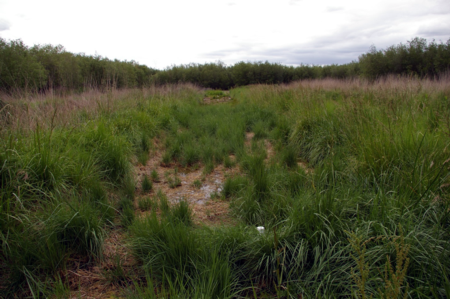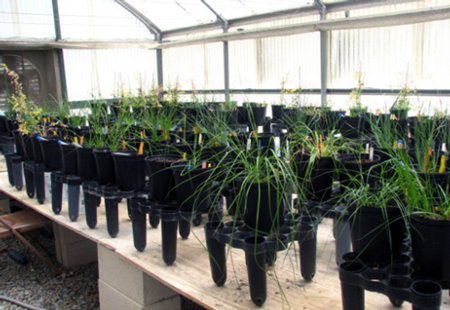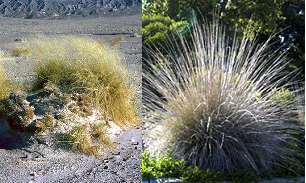Plant Selection for Vegetated Buffers: Plant Size vs Nutrient Uptake Efficiency
by Lea Corkidi, Donald J. Merhaut, Maren Mochizuki, Toan Khuong, Julie P. Newman, Oleg Daugovish, Ben Faber, José de Soto, Arturo A. Keller, María E. Sánchez-Coronado, Jeff Bohn, and Mike Evans
In previous newsletters, we addressed important considerations for the construction of non-vegetated and vegetated drainage channels that can be used to remediate the negative environmental effects of agricultural pollutants in storm water and irrigation runoff (Merhaut 2011; Merhaut and Corkidi 2011). Different studies have compared vegetated and unvegetated systems for wastewater treatment and have emphasized the key role of plants for nitrogen (N) and phosphorus (P) removal. N and P are two essential plant nutrients, but also two important water pollutants. This article refers to the relevance of proper plant selection to optimize the function of vegetated buffers to mitigate N and P runoff and leaching.
The use of different types of vegetated buffers (bioswales, filter strips and constructed wetlands), is one of the best management practices (BMPs) that has been recommended for filtering the excess of fertilizers and other pollutants from urban and agricultural runoff. These buffers reduce the movement of sediment and the delivery of various contaminants to water bodies. However, their effectiveness depends on several factors, such as size, runoff flow, climate, soils, vegetation cover and plant species.
In an on-going study on plant selection for vegetated buffers, we are comparing the ability of different plants to accumulate nitrogen (N) and phosphorus (P). In this article, we report results related to the nutrient uptake efficiency of two species of grasses that were established in a bioswale constructed near the Santa Clara River in Ventura County (fig. 1). Several stream reaches of this watershed have been included on the State 303 (d) list due to impairments that include benchmark exceedances of nutrients and agricultural pesticides.

Fig. 1. Bioswale established in the Santa Clara River watershed for research and demonstration of agricultural best management practices (BMPs) to improve water quality. Photo by Maren Mochizuki.
A series of bioswales were designed and constructed to evaluate their effectiveness in reducing pollutant discharge and improving water quality. The bioswales also served as a BMP demonstration. By monitoring the content of N and P in the water drained over the length of the bioswales, it was found that these systems were able to remove approximately 90% of the nitrate, ammonium and phosphate.
However, these bioswales were seeded with six different summer and winter varieties of grasses so it was not clear how each plant species contributed to the overall nutrient removal efficiency. Therefore, we conducted a greenhouse experiment (fig. 2) to compare the growth and nutrient uptake of Muhlenbergia rigens and Sporobolus airoides, two of the warm season grasses selected for this area.

Fig. 2. Greenhouse experiment to compare the growth and nutrient uptake of different species that could be used to optimize the function of biofilters to reduce nitrogen and phosphorus runoff and leaching. Some plants are taller and larger than others, but which ones can take up more nutrients?
Plant Size vs Plant Nutrient Uptake Efficiency
S. airoides and M. rigens were very different plants in terms of size and absolute nutrient uptake (fig. 3). It has often been considered that plant species with greater above and belowground biomass can take up and store more nutrients and therefore have greater capacities for nutrient removal (Jiang et al. 2011). However, our results suggest that plant size is not always a good indicator of plant nutrient uptake efficiency.

Fig. 3. Sporobolus airoides (alkali sacaton), left, photo ©1995 Saint Mary’s College of California; Muhlenbergia rigens (deergrass), right, photo by Mike Evans. S. airoides can reach 2 to 3 feet in height and can be found in alkaline flats, prairies, sandy plateaus and coastal scrub. M. rigens grows 2 to 4 feet tall by 4 feet wide and occurs in valley grasslands, streamsides and meadows, as well as mixed conifer forests and oak woodland plant communities. Both species flower in the summer, and tolerate periodic flooding and drought. In our growth experiment, M. rigens was taller and larger than S. airoides, but S. airoides was more efficient in taking up nitrogen and phosphorus.
M. rigens had greater shoot and root dry mass and accumulated a higher content of shoot N and P than S. airoides (table 1). However, nutrient uptake efficiency refers to the content of a nutrient per unit of plant biomass (i.e., mg of nutrient × mg of plant biomass), not to their content in the total biomass of the plant (absolute content of nutrient). While M. rigens had more shoot N and P than S. airoides, the latter species had double the concentration of shoot N and P (table 1). Therefore, M. rigens had more N and P because it was larger, but S. airoides was more efficient because it had more N and P concentrated in less amount of biomass.
Table 1. Growth response and nutrient uptake of Sporobolus airoides and Muhlenbergia rigens grown at 150 mg/L N during fourteen weeks.
| Shoot dry mass (g) | Root dry mass (g) | Shoot N % | Shoot N (mg) | Shoot P % | Shoot P (mg) | |
| Sporobolus airoides | 3.18 + 0.52 | 1.10 + 0.19 | 2.0 + 0.09 | 55.9 + 7.2 | 0.23 + 0.015 | 6.22 + 0.81 |
| Muhlenbergia rigens | 11.97 + 1.4 | 4.92 + 1.07 | 1.19 + 0.06 | 140.97 + 12.6 | 0.146 + 0.023 | 16.57 + 0.83 |
Our results show significant differences in biomass production, and content and concentration of shoot N and P that could influence the contribution of these species for N and P removal, indicating that proper plant selection can optimize the function of vegetated buffers to mitigate N and P runoff and leaching.
In addition, with proper plant selection, minimal maintenance of vegetated buffers can be achieved while maintaining optimal nutrient uptake. However, further studies are needed to extrapolate growth responses of these plants under natural conditions, since nutrient removal is not only influenced by plant nutrient uptake but also by their effects on microbial activity.
Lea Corkidi is Assistant Specialist, Department of Botany and Plant Sciences, UC Riverside; Donald Merhaut is Extension Specialist, Nursery and Floriculture Crops, Department of Botany and Plant Sciences, UC Riverside; Maren Mochizuki is Staff Research Assistant, Department of Botany and Plant Sciences, UC Riverside; Toan Khuong is Assistant Specialist, Department of Botany and Plant Sciences, UC Riverside;
Julie Newman is Floriculture and Nursery Crops Advisor, UC Cooperative Extension, Ventura and Santa Barbara Counties; Oleg Daugovish is Farm Advisor, UC Cooperative Extension, Ventura County; Ben Faber is Farm Advisor, UC Cooperative Extension, Ventura and Santa Barbara Counties; José de Soto is Director, UC Hansen Agricultural Research and Extension Center;
Arturo A. Keller is Professor, Center for the Environmental Implications of Nanotechnology, UC Santa Barbara; María E. Sánchez-Coronado is Research Assistant, Instituto de Ecología, Universidad Nacional Autónoma de México; Jeff Bohn is Owner of Tree of Life Nursery; and Mike Evans is Owner of Tree of Life Nursery.
References
Jiang FY, Chen X, Luo AC. 2011. A comparative study on the growth and nitrogen and phosphorus uptake characteristics of 15 wetland species. Chemistry and Ecology 27 (3): 263-272.
Merhaut D. 2011. Get cultured: drainage channels and vegetated strips in nurseries. UCNFA News 15(2): 7.
Merhaut D and Corkidi L. 2011. Get cultured: drainage channels and vegetated strips in nurseries. Part II. UCNFA News 15(3): 11-14.












